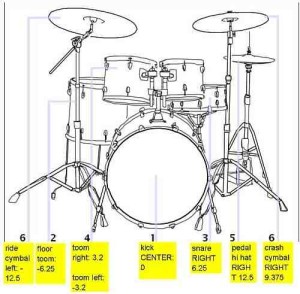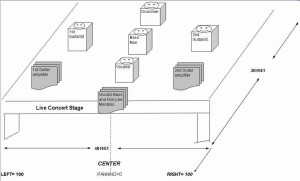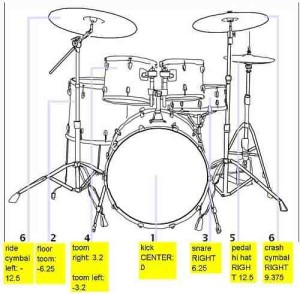In my recent post, I have mentioned that the whole drum instruments can be panned somewhere -12.5 to +12.5 settings.
There is a commenter on the post asking how to pan snare in the drums. In this post I will give my approach on how to pan drum instruments and parts (snares, toms, cymbals and hi hats). Panning properly drums can create a very realistic drum sound in stereo.

Below are the most important components of a drum kit and it’s panning settings :
a. Kick drum: “0”, this means it is panned to the center. The reason for this is that the drum set is placed in the physical center of the stage and kick drum is in the center of the drum set. Below is how the band looks like playing live on the stage and take note the drum set is in the middle.

b. Snare: “+6.25 right”, this means it is panned very slightly to the right. It is because looking at the real drum; it is located in the physical center between the hi-hats and to the center of the kick drum. Some engineers pan the snare to the center, but I do not recommend this since a significant frequency response of snare can drown the vocals.
c. Pedal hi hat: “+12.5 right”, this the farthest right of the drums.
d. Crash cymbal: +9.375 right”, it is located in the physical center between the snare drum and the hi hat.
e. Toom right: “+3.2”, again very slightly off center to the right.
f. Toom left: “-3.2”, the pair of the other toom but this one panned to the left.
g. Floor toom: “-6.25”, panned to the left and located in the physical center of the ride cymbal and the kick drum.
h. Ride cymbal– “-12.5” panned to the left, this is the leftmost part of the drum set.
The above settings works best for programmed drum loops (e.g. software-based such as from different drum sequencer). It is because they can be individually panned. A real drum recording with several microphones in the stereo field does not necessary to be panned individually. As long as the microphone placement and phase issues are considered.
Example drum panning techniques and calculations
I received an inquiry from a reader about drum panning: “I use GarageBand and the panning knobs only range from -64 to 64, not -100 to 100. In this case, do you know what the panning calculations would be.”
The main problem is that instead of having the usual -100 to +100 panning units settings as illustrated in this tutorial which is common in most audio mixing software; Garage band software is using -64 to 64 panning units. So how are you able to implement the drum parts panning settings for the image below in garage band?:

The solution will be to do some sort of ratio and proportion analysis:
Given:
The following drum panning settings are based on (-100 to +100):
Ride cymbal left: -12.5
Floor toom: -6.25
Toom right: 3.2
Toom left: -3.2
Kick center: 0
Snare right: 6.25
Pedal hi hat right: 12.5
Crash cymbal right: 9.375
Required: Compute the equivalent panning settings for GarageBand(-64 to +64)
Solution:
Let x be the equivalent settings
For ride cymbal left:
-12.5/100=x/64
x= -8 is the equivalent setting in Garage band
For floor toom:
-6.25/100=x/64
x= -4
For Toom right:
3.2/100=x/64
x=2
For Toom left:
-3.2/100=x/64
x=-2
For Kick center:
0/100=x/64
x=0
For Snare right:
6.25/100= x/64
x=4
For Pedal hi hat right:
12.5/100=x/64
x= 8
For crash cymbal right:
9.375/100=x/64
x=6
The above are the drum panning settings for Garage band by converting the -100 to +100 panning units to -64 to 64 conventions. Of course the above calculations are well applicable to other recording and mixing software that are using non-standard panning range. The above panning settings are based on a stage, audience perspective. For more details about the theory of panning in audio mixing, read the related tutorials below.
Content last updated on October 21, 2012









15 Responses
Wow, you have explained it very clearly JediBret. You are absolutely correct. Although the panning settings above are a rough guide, I find them useful when mixing drum samples such as taken from a drum sequencer where there is no panning or stereo field information.
But yes, you are correct that proper observance of phasing and putting microphones in the drums (overheads, etc) would make a strong difference in the final sound of the drums. I am planning to make a tutorial in the future about this topic. As of now, I am on the process of experimenting things to see what sounds good and bad then share what I’ve learned. But at least, you have contributed something valuable, I would also try your suggestions.
Thank you for your time in dropping by. Cheers.
If you use overhead mics, none of these numbers will have any relationship to anything of value. They are good starting places and that is it. Hand claps are traditionally done by a group of people, and they are Not all standing where the hat is. Pan your drums any darn way you want to. Use your ears – that’s why you have them. By simply setting things to these numbers, you will find (with some experienced listening) that it sounds different every time. All you have to do is move one mic one inch to totally screw up your balance.
Drum recording is an art and a science. The more mics you use, the more trouble you are asking for. It is all about phase and distance relationships. The problems are exacerbated further when you start messing with EQ and compression. If you don’t have phase issues nailed down before you start recording, you are in for hassles. For example, if the kick is out of phase with the snare mic and you pan the snare, you might make the kick disappear entirely, if the phase is perfectly matched, and you move the snare, you will move the kick, too. Now add in some overheads and viola, you have kick drum soup.
Start with your overheads and kick, get the stereo field to sound natural and the kick properly phase aligned, so that it has the right punch. THEN add the other tracks in and place them according to the overheads, when it all sounds nice and full and Tight, you are ready to move on.
Hi Luca,
Thanks for your inquiry, the details are provided in the above tutorial. Cheers.
I use GarageBand and the panning knobs only range from
-64 to 64, not -100 to 100. In this case, do you know what the panning calculations would be.
Hi Ed,
Yes, as long as you are using the same drum configuration as discussed in this tutorial. This means, one kick drum (at the center), one snare, two toms,one floor tom, one crash cymbal on the left and one ride cymbal on the right, one pedal hi hat.
Most heavy metal uses two kick drums known as double bass, so the panning for the kick drum can be approximated to still use the center.
Some heavy metal drums uses a much more complex drum set, so I recommend so you will visualize each of those parts and assign a more realistic settings like the way how I arrive/compute with the panning units discussed in this tutorial.
Good luck with your projects!
hello, thanks for posting such a detailed column on panning, now my only question is, would this apply to Heavy metal/deathmetal and extreme music?
Hi SylvainB,
Yes, feel free to experiment and always check your mix in mono to make sure those tracks still sound great whether in an stereo or mono monitoring system. Experimentation is important in mixing, the main objective is to produce a mix that will play in most audio systems.
IT is ok to experiment as long as you get the objective.
Cheers.
Hello guys,
Thank for this tuto about drums panning but can you tell me how panning drumsloops?
If I mix 2 loops (that i put mono), can i pan one of the about 10h and the other 14h to let free the center?
The problem is the kick which isn’t at the center
May I have to slice the loops and pan individually drum instruments or not necessary?
Thanks for your answers
the best drum set that I have used is the ones that is made by Pearl*.`
I prefer a wider panning on my drums, specially on toms and hihats because it makes those fierce fills with lots of 32ths notes really exciting. I like panning the hats almost halfway to either way to give it more presence. Though it can get a bit distracting some times if the song has not to many panned stuff.
Also, i prefer to use the “drummer perspective”, panning everything the other way around as you posted. This is just because I always wanted to play drums, and mixing them is the closest thing i get to.
Hi Matt,
Thanks for reading the article, yes it can be applied to dance or other genre if you take a live stage perspective of your mix.
For the clap, it is of the same position as pedal hi hat..(see figure above).
Hi,
Thanx for the great guide on panning.
I was only wondering if these ‘rules’ also apply making dance/house/electronical.
And if, how should I pan the clap? Same position as the snare?
Regards,
Matt
Hi Pej,
Thanks for reading also, and I appreciate your time in visiting my blog. Good luck in panning your drum instruments.
Regards,
Emerson
i appreciate this post, very simple and logical to understand.
thank you
Thank your for 1st picture…
i cleared my doubts with this post…
regards